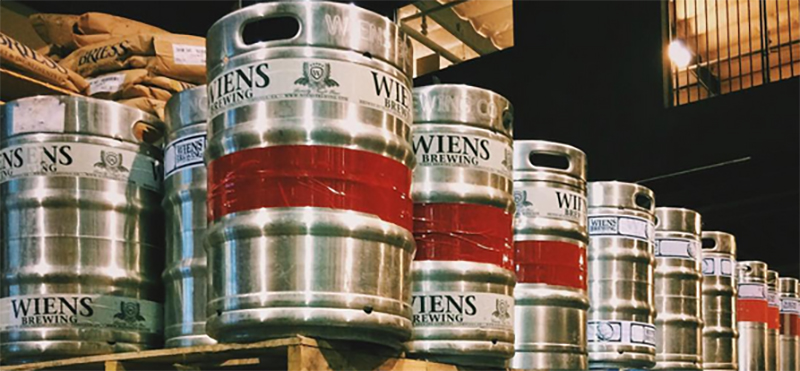
Brewery safety has become a very important part to the growing brewing industry. It’s good to see the Ohio Craft Brewers Association team with OSHA and other state officials to provide resources and guidance to ensure a safe working environment for a brewery’s staff.
But assessing risk factors isn’t just caustics and slip and falls or worker’s comp, it’s knowing what could go wrong and protecting yourself from all of it. That means understanding risk factors everywhere.
SPOILAGE: Fermentation temperature control, oxidation and wild organisms … all play wild cards in finishing with a consistent and clean brew. For breweries that lager, hitting precise temperatures are crucial. Cold rooms, glycol and horsepower are vital to success.
For Oregon’s Heater Allen Brewing, getting the 1,300 barrels per year of lagered beer means keeping things cold.
A glycol system is pretty easy to maintain, said Heater Allen’s Lisa Allen.
“The two things that we have done to keep it up and running properly are to make sure it has enough glycol and on really hot days we will sometimes spray the system with cold water — ever since we started using a cold liquor tank we haven’t had to do this,” she said.
Watching the viscosity of the mixture is important. Glycol is not cheap, and of course, brewers would rather have more water in the system.
“You could run all glycol, and you would have a very low chilling temperature, but then you are risking other problems in that, yes, you would be chilling your tanks, but you would be putting a layer of ice in your beer. That causes other problems,” said Yards Brewing’s director of quality control, Frank Winslow. “You need to find that balancing act where it drops your temperature effectively but it doesn’t make beersicles in your tank, which can be dangerous.”
Brewing is problem solving and trying to figure out a more efficient way to do things, Winslow explained when talking about improving quality in beer.
But, with each addition of extra testing or more complications, a brewery is adding a price.
“But you are buying some other aspect of consistency or confidence in the product or assurance of the process,” Winslow noted.
Some of those quality insurances include microbiological control and management.
CLEAN CO2: Sometimes forgotten, CO2 is an ingredient in a brewery’s product. It’s application can help in achieving proper mouthfeel and the look of a certain beer.
“Brewers should ensure that they purchase beverage-grade gases from suppliers that understand and comply with FSMA (Food Safety Modernization Act) regulations,” said Sal Calandra, Food Quality and Safety Manager for Linde LLC.
The implementation of a Hazard Analysis Critical Control Point program by a supplier can identify and mitigate a potential food safety risk in the carbon dioxide supply chain.
Calandra said that some previous best practices pertaining to the supply of beverage-grade gases are now mandatory under new FSMA requirements and he noted that as part of its own food safety programs, brewers should ensure that their beverage gas suppliers, including distributors, are also in compliance.
Some of these mandatory requirements include a detailed written procedure; employee training programs; product traceability programs; risk assessment programs; approved food safety plans; and food safety audits.
TAPROOM LIABILITY/SAFETY: When running a taproom, there’s more than pouring and talking beer. Keeping customers safe and protecting the brewery’s liability is key.
Unfortunately, you can’t predict every possible scenario that could play out, so it’s important that the bar staff understands general goals as an establishment in terms of safety.
Using Training for Intervention ProcedureS (TIPS) and getting your staff certified is one way. Not over serving, or even not serving customers that come into the taproom already intoxicated, is probably the most common form of ‘risk management’ servers and taproom managers engage in. After that, preventing underage drinking through proper identification practices is a big priority.
“We have also been known to ID a second time at the bar,” explained Saint Arnold’s Priscilla Walker.” As an employee, if you are not comfortable serving someone, or have a thought that he or she is younger than 21, it’s perfectly acceptable to ask for identification a second time.”
UP TO CODE: Health inspections are a big part of a brewery’s production. Being prepared and setting up guidelines can be a key between having a brewery continue as normal or being shut down for a while to fix any problems.
“You pretty much have to be ready for an inspection at any moment,” said co-founder and Yellowhammer GM Ethan Couch. “We do mock inspections every so often to remind the staff and managers what to look for. Every agency has their tick-list. It’s usually common sense, but knowing the law and having systems in place to help the staff keep organized makes a big difference.”
Fat Bottom Brewing put a lot of focus on quality improvement during the expansion of the brewery, which Drew Yeager said he did not want to limit to just QA/QC. That meant developing a safety training program, with staff having to go through annual training on all OHSA required areas for food manufacturers.
“My team and I developed different monthly audits to help identify areas for continuous improvement,” Yeager said.
Each month, the head of the brewery’s QA/QC department and Yeager perform audits for Quality Assurance, Quality Control, Good Manufacturing Practices, and Safety. Each audit generates a score similar to a health inspection and the audits are done unannounced throughout the month.
Some sticking points that breweries know agencies will focus on include especially Good Manufacturing Practices.
“I have also heard lot traceability is a hot ticket item for the Department of Ag. and the FDA,” Yeager said. “I had to do a complete overhaul on our inventory management to build in lot traceability. We changed the software we use, which has allowed us to track everything that makes it into a packaged product.”






1 Trackback / Pingback